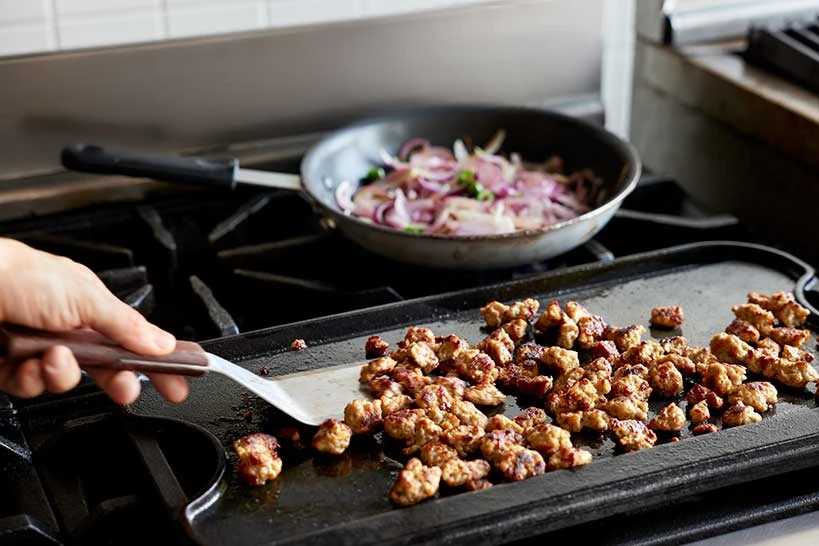(What IF?)
Employee Highlight: Irene Yim

Today, we’re making history for the second time(opens in a new tab) in one month with the international debut of Impossible™ Pork Made From Plants(opens in a new tab) – once again beating the animal with a product that consumers prefer over ground pork from pigs. In a blind taste test of more than 200 consumers in Hong Kong, 54% thought Impossible Pork tasted better than ground pork from pigs, and the product scored higher in every category tested, including flavor liking, texture liking, and purchase intent. Irene Yim, an R&D Culinary Manager at Impossible, led the culinary innovation behind the product. Here is the story of how Irene and her team made Impossible Pork as versatile as and even more delicious than ground pork from pigs.
Yet again, Impossible Foods is beating the animal in every way that matters to consumers. Impossible Pork Made From Plants – launching today at Chef David Chang’s Momofuku Ssäm Bar(opens in a new tab) and at more than a hundred restaurants across Hong Kong next month – scored higher in a test of more than 200 Hong Kong consumers on all attributes tested, including overall liking, appearance liking, flavor liking, texture liking, and purchase intent. So how did we take one of the most consumed and versatile animal proteins in the world and recreate it from plants in a way that looks and tastes more delicious? It started with a deep understanding of the food culture and the recipes associated with ground pork, including how professional and home chefs across the globe cook with it. Irene Yim, an R&D Culinary Manager at Impossible Foods who helped design the recipe, was the perfect leader for the task.
Creating a Baseline
Irene’s team helps Impossible Foods take product prototypes and put them to the test in delicious and diverse dishes — work that’s crucial to our product development process. Just like animal meat, our products are designed to work in every recipe, and that was more important than ever with Impossible Pork. “There’s a very different expectation of the way pork performs if you’re making Shumai vs Bolognese,” Irene said. Her experience perfectly unites food science and practical expertise in professional kitchens, giving her a great baseline for understanding how chefs will expect to work with a product. “I really do think my background is an integral part of how I approach things,” she said.
The Impossible Pork development process focused on Asian cuisine from the beginning. Guided by Irene’s existing knowledge of ground pork recipes and applications from her years of work in Asian restaurants, Irene and her colleagues began collecting all the research they could find on the most important attributes of ground pork. They created an outline of all the different cooking methods for the product: stir frying, wok frying, roasting, deep frying, steaming, sauteing — you name it. Then they thought about all of the different forms: meatballs, crumbles, dumplings, and more.
Once they compiled this research, they had a framework for testing Impossible Pork across a variety of recipes. Next, they fired up the stove and brought in the experts (including some chef-minded colleagues at Impossible Foods) for what they call the “culinary validation” process — the trialing of Impossible Pork in all the applications they could think of.

Putting Impossible Pork to the Test
When evaluating Impossible Pork, Irene and her team focused on the flavor and texture expected for each dish. In some applications it might be soft, in others chewy, in others gritty. “There’s a time and place for each of those textures in an end product, depending on what the dish is, so we really worked on refining that in culinary testing,” Irene said. The biggest challenge in developing Impossible Pork was making sure the texture delivered in every dish, across cultures and cuisines.
Irene recalled one of these hurdles when they tested Impossible Pork in a Shumai (steamed Chinese dumplings) recipe, one of close to 100 tastings Irene’s team prepared with Impossible Pork. After steaming the dumplings, her team noticed that they didn’t have that fatty, bouncy, almost “al dente” quality characteristic of traditional Shumai made with animal-based pork. So they worked closely with Mona Zou, a lead developer for Impossible Pork on the Product Innovation team, to create a next generation formulation that would perform the same way as pork from pigs in the hands of a Chinese chef.
In addition to doing tastings with colleagues, Irene and her team worked with well-known Chinese chefs with over 10 years of experience cooking Asian cuisine professionally to perfect the product. They asked the chefs to cook at least two traditional dishes with Impossible Pork and share what their impressions were at each stage of handling it – from their first experience working with it raw (mixing, marinating, and shaping) to its performance in different cooking processes (dry frying, marinating, steaming, etc). The Product Innovation team was able to use this feedback to continue iterating on the recipe, working with Irene’s team to test each one.
“That layer of feedback from Chinese chefs was really valuable and really gave us more insight on expectations and acceptance for each formulation,” Irene said. "When working on these products, we all bring a different perspective from our preferences and past experiences so the more culinary testing feedback we have, the better.”
Irene has worked on countless recipes across a variety of different Impossible products over the years, but this one might be her favorite. “I have to say, the flavor stands out. I can definitely say that it’s porky, but as a chef I think it’s even more versatile than our burger, especially for Asian food.” This versatility makes it the perfect canvas for an even wider array of global recipes. Irene’s favorite? “Hot pot! I love a bold Impossible Pork meatball eaten with hot soup. It’s got that natural pork bounciness and it really absorbs the flavors.”
Culinary Roots
Irene grew up spending a lot of time in Chinese restaurants — her parents are from Hong Kong and Guangzhou and owned and operated multiple restaurants in the Bay Area, where she helped them cook and run the business. After high school, she went to culinary school in San Francisco at Le Cordon Bleu, going on to work at prominent restaurants in California and Singapore. She even did a stint as a cheesemonger in New Orleans before returning home to her native Bay Area to work with Chef Martin Yan (of the popular PBS program Yan Can Cook) on his cookbooks and recipe development.
After years in the restaurant industry, she discovered the food science program at UC Davis and went back to school, developing an interest in biology and chemistry. “Diving in and being obsessed with what I do is easy for me,” Irene said, and her studies at Davis were a perfect addition to her culinary expertise. When she graduated, she applied to work as an R&D Chef at Impossible Foods.
She now manages a team of close to 15 scientists and culinary experts focused on running our research test kitchen and performing culinary validation for all of our products. She immediately felt at home at Impossible Foods because she found the startup mentality similar to that of some of the restaurant kitchens she worked in, with new challenges every day. “I was worried that I might be bored at some big corporate company where I was kind of stuck in a box. People here are really expected to stretch, to reach their potential, to build something.” One of her favorite things about her job is watching her colleagues grow, excel, and even move to other parts of the R&D team. “Impossible Foods really believes in its employees and how much they can grow here, and really allows that to happen.” Impossible Pork was just the latest example of Irene and her team building something incredible together, and it won’t be the last.
While we chose to highlight Irene and her story here, she made sure to give a big shout out to Mona Zou, Mallory Mau, Miles Laird, Andrew Caffrey, Olivia Nahoum, Jenny Mi, and the rest of the R&D Culinary and Product Innovation Teams, all of whom were instrumental in bringing this product to life (among many others at the company). One team, one dream!